Gbakon S. Andrew1, Ubwa T. Simon1, Ahile U. John1, Obochi O. Godwin2, Nwannadi I. Alexander2, Yusufu M. Ikagu3
1Department of Chemistry, Faculty of Science, Benue State University, Makurdi, Nigeria
2Department of Biochemistry & Haematology, College of Health Sciences, Benue State University, Makurdi, Nigeria
3Department of Food Science, Federal University of Agriculture, Makurdi, Nigeria
Correspondence to: Gbakon S. Andrew, Department of Chemistry, Faculty of Science, Benue State University, Makurdi, Nigeria.
| Email: |  |
Copyright © 2018 Scientific & Academic Publishing. All Rights Reserved.
This work is licensed under the Creative Commons Attribution International License (CC BY).
http://creativecommons.org/licenses/by/4.0/

Abstract
The aim of this paper is to investigate the changes in several haematological and plasma biochemical parameters in Wistar rats fed on diets containing Mango fruits ripened with calcium carbide. Fruits from two relatively new mango varieties (Mangifera indica L.) namely Broken and Mummy grown in Benue State Nigeria, were artificially ripened using calcium carbide. The pulp of these fruits was mixed with the normal rat feed and given to the rats for three weeks. Haematological and plasma biochemical analyses were carried out on the whole blood and plasma respectively. The results showed that calcium carbide ripened mangoes caused significant decrease in Red Blood Cell (RBC) count, Haemoglobin, Packed Cell Volume (PCV) and increased the White Blood Cells (WBC) and Lymphocytes. The data obtained showed the depletion in creatinine, protein, cholesterol, potassium and bicarbonate while albumin and bilirubin significantly increased. There was no remarkable change in the levels of Aspartate aminotransferase (AST) and Alanine aminotransferase (ALT) during the period of the study. The measured parameters in this study are valuable indicators of health and stress in living organisms. Findings from this study suggest that consumption of calcium carbide ripened mangoes is causing changes in the haematological and plasma biochemical profiles of consumers; hence that may increase erythrocytes destruction, have suppressive effect on the three major cell lines and interfere with some minerals and vitamins as well as lipid metabolism. This may consequently manifest in series of health hazards, lowering the body’s ability to resist infection and weakening the whole immunity system when consumed.
Keywords:
Calcium carbide, Artificial ripening, Mango fruits, Haematological, Biochemical
Cite this paper: Gbakon S. Andrew, Ubwa T. Simon, Ahile U. John, Obochi O. Godwin, Nwannadi I. Alexander, Yusufu M. Ikagu, Studies on Changes in Some Haematological and Plasma Biochemical Parameters in Wistar Rats Fed on Diets Containing Calcium Carbide Ripened Mango Fruits, International Journal of Food Science and Nutrition Engineering, Vol. 8 No. 2, 2018, pp. 27-36. doi: 10.5923/j.food.20180802.02.
1. Introduction
Fruits provide vital nutrients in human diet by supplying the necessary growth regulating factors such as vitamins, minerals, complex carbohydrates, proteins, lipids and antioxidants essential for maintaining normal health [1, 2]. They are widely distributed in nature, commercially important and nutritionally essential food commodity and can be consumed raw. Apart from the consumable part of the fruits, the by-products, such as the fruit peels and the seeds could represent excellent components for food, medicinal or cosmetic purposes. Among the fruits, mango (Mangifera indica L.) in the Anacardiaceae family widely found in tropical and subtropical regions is one of the most important commercial crops worldwide in terms of production, marketing and consumption. Mango fruits ripen rapidly after harvest. The fruits are susceptible to diseases [3]. They perish quickly due to ripening and softening which limit the storage, handling and transport potential of the fruit [4]. Mango fruits are therefore harvested when they are immature and mature green. Post-harvest treatment of mango fruits is a key challenge in Nigeria [5]. Ripening is done naturally or artificially and this leads to fruit maturity before consumption or processing [6]. The key factors that influence the practice of artificial ripening include high demand of seasonal fruit and possible economic loss during fruit storage and distribution [7]. The common practice currently is to harvest mangoes in bulk in a single picking, which includes fruits of different stages of maturity thus contributing to 40-60% postharvest losses [4]. To overcome these problems, mango fruits can be exposed to chemical ripening agents such as calcium carbide, acetylene gas, ethephon, etc for a short period which activates ripening [7]. Calcium carbide which is most commonly used because of its cheapness and availability liberates acetylene gas when it reacts with water. This gas initiates ripening in the mango fruits [4]. The commercial graded calcium carbide is impure. Calcium phosphide (Ca3P2) and calcium arsenide (Ca3As2) present as impurities in CaC2 react with water to form phosphine (PH3) and arsine (AsH3) respectively. These hydrides are fat soluble, and may dissolve in the wax layer of fruits and can diffuse from peel to flesh of fruits, which cause health hazards [8]. Dizziness, headache, fatigue, nausea and vomiting may be the symptoms when such fruits are consumed and when exposed to high concentrations may cause loss of consciousness [7]. Preliminary studies in Benue State, the central mango growing area of Nigeria, indicate the indiscriminate commercial application of calcium carbide on the different varieties of mango fruits to enhance ripening. During transportation, the naturally ripened fruits may become over ripen and inedible. Sometimes fruit sellers chemically ripen the immature fruits in order to avoid loss, meet the high demand and make high profit. The fruits ripened with calcium carbide may develop uniform attractive surface colour, but poor in flavour and the inside may remain unripe. Even though the use of calcium carbide accelerates ripening, it affects the nutritional quality of fruits and is harmful for human health. There are increasing reports of food poisoning due to the use of chemical ripening agents such as calcium carbide. This ripening agent is alkaline in nature and irritates the mucosal tissue in the abdominal region. Cases of diarrhea, vomiting, abdominal pain and headache, after eating carbide ripened mangoes have been reported recently [9]. Other serious health hazards include failure of the neurological system resulting in dizziness, sleeplessness, confusion and seizures on a short term basis. In the long term, it can cause memory loss and cerebral edema [7]. The rising demand of fruit safety has inspired researchers about the risk related to the use of chemically ripened fruits and foods contaminated by pesticides [10].The present study was therefore conducted to investigate the possible changes in haematological and blood plasma biochemical parameters in wistar rats fed on diets containing calcium carbide ripened Broken and Mummy varieties of mangoes in Benue State of Nigeria.
2. Materials and Methods
2.1. Plant Material
The Chief Technologist and Herbarium Curator, Department of Biological Sciences, Benue State University identified the mango species as Mangifera indica L. in the Anacardiaceae family. Broken and Mummy were accordingly identified as two of the many varieties of mango. In the study, forty uniform, mature green, undamaged and healthy fruits of Broken mango variety were randomly harvested from a mango orchard in Gbem and Mbaikon settlements of Tsambe Ward in Vandeikya Local Government Area, Benue State. The average weight of the fruits was 0.73kg. Similarly, another twenty fruits of Mummy mango variety were also harvested from the same orchards on the same day. The average weight of the Mummy variety was 1.40kg. Weight of the mango fruits was recorded using analytical weighing scale RS 232, Adam model. The sixty fruits were washed with water to remove the latex and shade dried until no moisture was visible on the fruit surfaces. The fruits were packed into wooden baskets and transported to the laboratory of the Department of Chemistry, Faculty of Science, Benue State University Makurdi and kept at room temperature. Calcium carbide was bought from a welding materials shop at the Makurdi Modern Market and used as a ripening agent.
2.2. Mango Fruits Treatment with Calcium Carbide
The mango fruits were divided into four groups for each of the varieties labeled B1, B2, B3 and B4 representing the Broken variety while Mummy fruits were designated M1, M2, M3. Each variety was subjected to three levels of calcium carbide treatments as follows: 2g, 4g and 6g calcium carbide per kg of fruit to induce ripening; while B1 and M1 were the controls (without calcium carbide) for Broken and Mummy respectively. Calcium carbide was crushed into small pieces and weighed using analytical weighing balance PW 184 Adam model.The reported method [11] was used in this study to quicken the ripening process of the mangoes fruits as described.In this method the fruits were exposed to acetylene gas released from calcium carbide. Calcium carbide was placed in small perforated plastic container and kept at the bottom of each rectangular plastic container. The carbide was moistened with few drops of water to release the gas and the fruits were exposed to this gas in airtight portable plastic tents. The fruits were placed in ventilated plastic crates inside air-tight plastic boxes. After 24 hours of exposure, the fruits were taken out and left to complete the ripening process at room temperature. Room temperature and humidity readings were recorded daily. Fruit ripening was monitored. The standard for maturity was the appearance of a yellow-orange colour outside the fruit and soft texture using a penetrometer. The time required for ripening of the fruits in all the groups was recorded.When fully ripened the fruit peels were removed and the pulp from each treatment was separately fed into a Qlink Blender model QBL-20L330 China, and then homogenized. The resulting pulp from each group of fruits was pooled to form eight respective composite samples (B1, B2, B3, B4 and M1, M2, M3, M4). The resulting pulp (juice) was thereafter introduced into plastic bottles, properly labeled and preserved in a refrigerator at 15°C for use in the animal experiment.
2.3. Animal Material
The experimental animals were purchased from the Animal House of College of Health Sciences (CHS), Benue State University Makurdi where the feeding trials were also carried out in accordance with the US National Institutes of Health Guidelines for the care and use of laboratory animals [12]. The Provost CHS approved the purchase and use of wistar rats as well as the Animal House Laboratory facilities for the study. All the experimental animals were handled in accordance with the US National Institutes of Health Guidelines for the care and use of laboratory animals.45 male albino rats (wistar strain) of age 16 weeks old weighing between 150g and 175g were randomly assigned into nine groups according to body weight, and kept in clean plastic cages under a 12/12 hours light/dark cycle. The rats were allowed to acclimatize to the laboratory environment for a period of one week before commencement of the experiment. They were then randomly assigned into nine groups A to I (I being the control group). Each cage had 5 rats. Room temperature and humidity were monitored daily using a digital temperature and humidity instrument. The rats were fed with pelletized mash obtained from UAC Vital Feeds store in Wurukum Market, Makurdi. Drinking water was available ad libitum throughout the study.Pulp from the previously ripened Broken and Mummy mango fruits by calcium carbide kept in the refrigerator were then mixed with the pelletized mash and fed to the rats in each group according to the level of calcium carbide used for the ripening. The blended mango pulp was mixed with the rat feed according to the method [8]. About 20 g of mango pulp was thoroughly mixed with 80 g of feed which also acted as a carrier. Feeding of the rats was done once daily for three weeks. Left over water was discarded. The left over feed was weighed and recorded to determine the daily feed consumption, thereafter the left over was also discarded. Table 1 shows the allotment of the diets to the various groups. Table 1. Allotment of Diets to Rat Groups
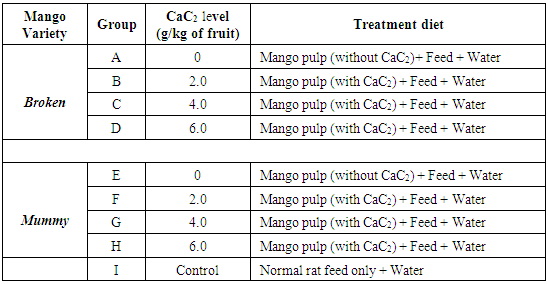 |
| |
|
2.4. Physical Observation and Mortality
Clinical observation was made once a day for mortality, ill health or reaction to treatment, such as changes in skin and fur, eyes and mucus membranes, behaviour pattern, salivation and diarrhea.
2.5. Body Weight, Food and Water Consumption
The body weights of each rat were recorded at the end of every week. The differences of the weights were recorded. The amount of feed placed in the feed tray was 200 g for each group and this amount was enough for the whole day. The amount of feed left in the tray was weighed every morning and calculated to obtain the amount of feed consumed. The body and feed weights were measured using Citizen MP-2000 weighing scale. Water was given ad libitum.
2.6. Hematology and Plasma Biochemical Analysis
At the end of three weeks, the wistar rats were weighed and sacrificed after being anaesthetized using chloroform. About five ml of blood was collected from the rats by cardiac puncture. One ml out of the blood collected was transferred in labeled sterilized vials containing anticoagulant EDTA (Ethylene Diamine Tetra Acetic Acid) and used for haematological investigations. About four ml of blood collected was transferred into lithium heparin containers. The blood samples were spun with a bucket centrifuge at 4000rpm for 5 minutes so as to separate the plasma from the packed cells. The plasma obtained was kept in plain blood containers and used for biochemical analysis [8]. Haematological analysis was carried out at the Department of Haematology, Benue State University Teaching Hospital using automated Sysmex XE-5000 haematology analyzer, Japan. The plasma biochemical analysis was done at the Federal Medical Centre, Makurdi using automated analyzer COBAS Integra 311 England.The parameters measured were total white blood cell (WBC) count, hemoglobin (HGB), red blood cell (RBC), hematocrit (HCT), mean cell volume (MCV), mean corpuscular haemoglobin (MCH), mean corpuscular hemoglobin concentration (MCHC). Others included RDW-SD, RDW-CV, PWD, MPV, P-LCR as well as lymphocyte %, lymphocytes number and platelets (PLT). Clinical biochemical values determination was for liver profile (total protein, albumin, creatinine, alkaline phosphatase (ALP), alanine aminotransferase (ALT) and aspartate aminotransferase (AST). Urea was also determined. Plasma electrolytes were determined, and values obtained for sodium ion (Na+), potassium ion (K+), chloride ion and bicarbonate ion concentrations were determined using the methods of AOAC [13]. Other biochemical parameters included LDL, HDL-cholesterol, cholesterol and triglycerides for lipid profile. Component lipids were estimated using the GPO-PAP method for estimation of total cholesterol.
2.7. Statistical Analysis
Statistical analysis involved use of the Statistical Package Sciences (SPSS). All findings such as changes in animal body weight, feed consumption, hematology and blood plasma biochemistry were tabulated and analyzed. Results were reported as Mean ± Standard Error of Mean (SEM). Percentage differences were calculated, the statistical difference between more than 2 groups of data was evaluated using analysis of variance (ANOVA) with Bonferroni post hoc test. Students t-test was also used to compare the mean values and results were considered significant when P < 0.05.
3. Results
Summary of the results of the study are presented in Tables 2 to 8. Table 2: Effects of consumption of mangoes treated with calcium carbide on haematological parameters Group I (WBC, RBC, HGB, HCT, MCV, MCH and MCHC)Table 2. Effects of consumption of mangoes treated with calcium carbide on haematological parameters Group I (WBC, RBC, HGB, HCT, MCV, MCH and MCHC)
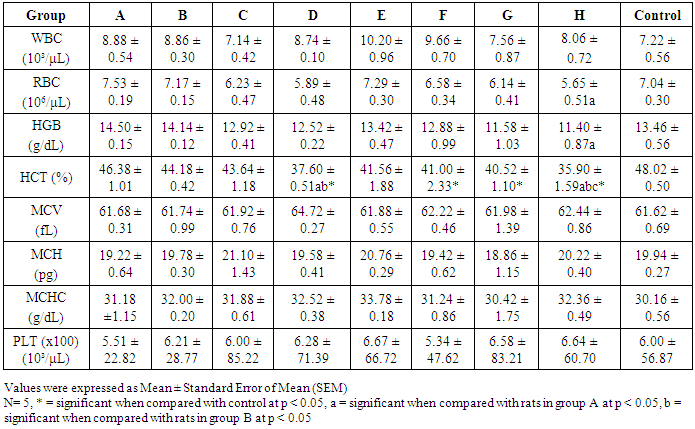 |
| |
|
Table 3. Effects of consumption of mangoes treated with calcium carbide on immune cell profile
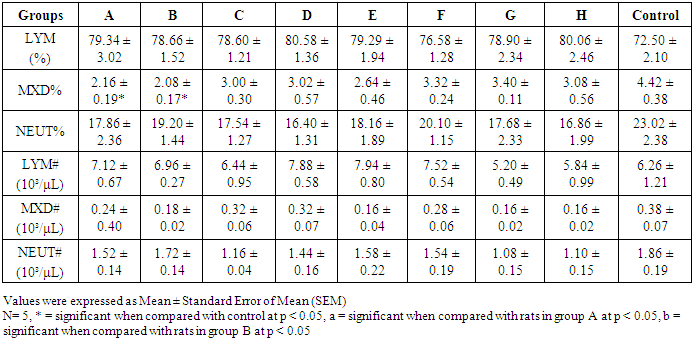 |
| |
|
Table 4. Effect of consumption of mangoes treated with calcium carbide on plasma urea, creatinine, proteins, liver enzymes and bilirubin
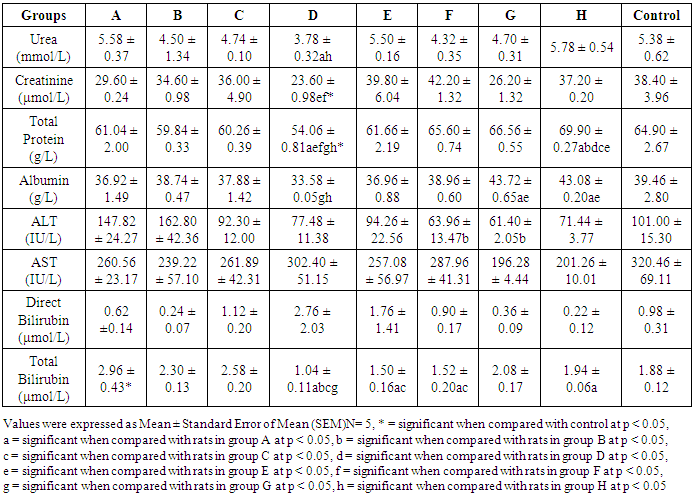 |
| |
|
Table 5. Effect of consumption of mangoes treated with calcium carbide on plasma electrolytes
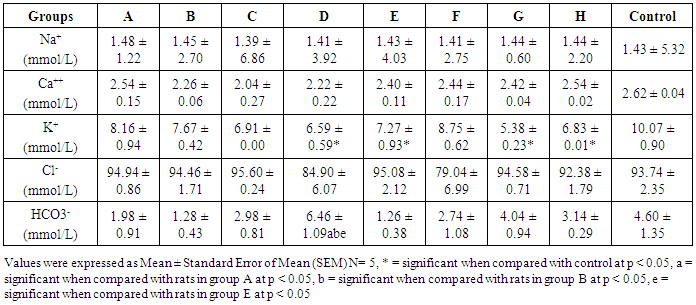 |
| |
|
Table 6. Effect of consumption of mangoes treated with calcium carbide on plasma lipid profile
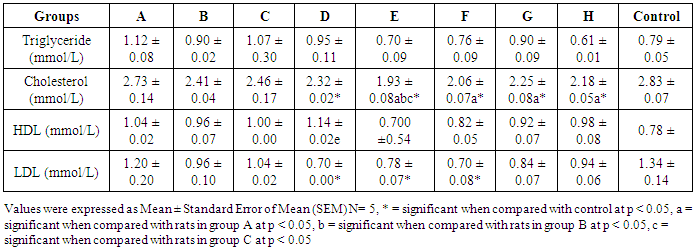 |
| |
|
Table 7. Changes in quantity of feed consumed
 |
| |
|
Table 8. Changes in body weight during consumption of mangoes treated with calcium carbide
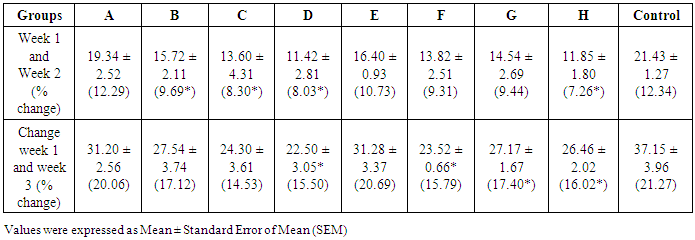 |
| |
|
4. Discussion
4.1. WBC
Table 2 shows that WBC increased above the control in almost all the groups. This result is in agreement with [8] who observed significant increase in WBC when calcium carbide was used as a toxicant. Similar findings were reported when some researchers evaluated the haematopoietic effects in mice arsine gas poisoning [14]. Study on haematological alteration in European rabbit, Oryctolagus cuniculus exposed to ethereal -a toxic fruit ripening agent also showed significant increase in total WBC [15]. WBC plays a major role in the defense mechanism in animals. An increase in WBC and the raised level of the lymphocytes which is a component of the WBC may be defense against the invading toxicant. The increase may result from mobilization of migrating WBC or as a result of reactive leukocytosis in the face of offending agent. Indeed, the WBC level in treated groups is greater than that of control (but except for group C). Nevertheless, it can be noticed that the increases in WBC is not consistent with the dose (A, no calcium carbide has the greatest value, B is comparable, C decreases and then it increases again for D, maximum calcium carbide dose). This may be an indication that parameters’ variation may not always be dose consistent.
4.2. RBC and Haemoglobin Concentration
Decreased RBC as shown in table 2 may be due to an inhibited production or by increased erythrocyte destruction. It could also be due to lower level of erythropoietin [16, 17]. Some researchers reported that reduction in RBC count may be due to microcytic or normocytic anemia. It has been reported that altered RBC morphology due to hemolytic anemia in humans is consistent with effects observed in laboratory animals and include increased leukocytosis, red-cell fragments, and ghost cells [16, 17]. Calcium carbide may also interfere with some elements and minerals necessary for erythropoiesis e.g. iron, folic acid and Vitamin B12 [18]. Calcium carbide showed effect on haemoglobin in this study which is in agreement with other workers. Lyses of erythrocytes may lead to decreased hemoglobin content which may result to a number of pathological conditions such as increased sedimentation of erythrocytes [14]. In another study erythropenia seem to be due to reduced haemoglobin content with haemopoiesis. The anemic state may be due to inhibition of erythropoietin or disturbance of haemoglobin synthesis [19]. The decrease in RBC and hemoglobin in the study agrees with works of these previous researchers.
4.3. Hematocrit or Packed Cell Volume (PCV)
Hematocrit or Packed Cell Volume (PCV) is the percentage of red blood cells (RBC) in the whole blood. As explained earlier, the decrease in PCV in table 2 maybe from:i) The toxic effect of calcium carbide on the bone marrowii) Interference with micronutrients for red cell productioniii) Inhibition of erythropoietin iv) Increased haemolysis of the red cells from the toxic effect of the calcium carbideSimilar findings were recorded by [20, 21]. Changes in PCV values have been associated with stress, impaired osmoregulation and electrolyte loss [8]. This suggests that the calcium carbide induced oxidative stress resulting in impaired osmoregulation and electrolyte loss.
4.4. Red Cell Indices (MCV, MCH, MCHC)
Increase in MCV, MCH and MCHC as indicated in table 2 supports the idea that the anaemic effect of calcium carbide is more likely from haemolysis and interference with some vitamins especially vitamin B12 and folic acid but not iron. An increase in MCV MCH, MCHC values even though not significant was noticed in comparison to the control, however a significant increase in the values have been reported [14, 16] probably due to longer period of the experiment. These researchers investigated the hypothesis that hemolytic effects of arsine gas involve oxidative stress by arsine on erythrocytes, which resulted in denaturation of HGB and cell lysis. A significant increase in the mean corpuscular HGB concentration (MCHC) also occurred. An increase in MCV value may be due to swelling of RBC and/or disturbance of osmoregulation and reduction in erythrocytes. Rise in MCV values seems to be correlated with decline in RBC count.
4.5. Platelets
Platelets count measures the number of platelets. They are important for blood clotting. Increase in platelets may be due to reactive thrombocytosis as a result of haemolysis that resulted from toxic effect of the calcium carbide on the red blood cell. The effect of consumption of mangoes ripened with Calcium carbide on immune cell profile is shown in table 3. The immune cell profile includes:
4.6. MXD
MXD is made up of monocytes, eosinophils and Basophils. The reduction in MXD may be a consequence of the toxic effect of calcium carbide on this group of cells as seen in erythrocytes.
4.7. LYM, NEUT%, LYM#
The idea that calcium carbide may have suppressive effect on the haemopoietic cell is likely correct as the whole major cell lines were depressed. It can therefore be inferred that calcium carbide has some degree of myelo (bone marrow) suppressive effect.
4.8. RDW-SD (Standard Deviation) and RDW-CV (Coefficient of Variation) %
Red cell distribution width indicates the average size of the red blood cell. As discussed earlier, the rats fed on feeds treated with calcium carbide had large RDW. This could also be attributed to interference with folic acid or vitamin B12 metabolism by calcium carbide.Increase in WBCs and lymphocytes may arise from stimulated lymphopoeisis and/or enhanced release of lymphocytes from lymph tissues [22]. This lymphocyte response might be a direct stimulatory effect of toxic substances on lymphoid tissues. Alternatively, this response may be assumed to be associated with the gastric irritants’ induced tissue damage and disturbances of the non-specific immune systems, leading to increase production of leukocytes [23]. Also, a decrease in the percentage of neutrophils in peripheral blood may be due to apoptosis. Generally, neutrophils are known to be involved in the phagocytosis of foreign chemical substances in the body, during which some of them are ruptured. This may therefore explain why the neutrophils count consistently decreased following administration of gastric irritants such as calcium carbide in rats.
4.9. Plasma Electrolytes
Electrolytes generate positively and negatively charged species called ions. Electrolyte measurements may be used to help investigate conditions that cause electrolyte imbalances such as dehydration, kidney disease, lung diseases, endocrine (glandular) or heart conditions. High or low electrolyte levels can be caused by several conditions and diseases. In the current study there was significant decrease in potassium and bicarbonate levels. The imbalance in these electrolytes may suggest the interference of the toxicant (calcium carbide) with the rats’ ability to maintain regular heart rhythm. The kidney maintains the acid-base balance of the body. The imbalance in these electrolytes may suggest a deficiency in the ability of kidneys to main the balance which may lead to oedema; a condition where an excessive accumulation of serum is found in tissue spaces or body cavity [8]. Generally, they are affected by how much is consumed in the diet and absorbed by the body, the amount of water in a person's body, and the amount eliminated by the kidneys. They are also affected by some hormones such as aldosterone, a hormone that conserves sodium and promotes the elimination of potassium. An electrolyte imbalance can lead to various problems, including dizziness, cramps, irregular heartbeat, and possibly death.
4.10. Kidney and Liver Functions [Plasma Urea, Creatinine, Proteins, Liver Enzymes and Bilirubin] Protein
Protein is important for structure, function, and repair of tissue and required for tissue building. The reduction in protein indicates increased proteolysis. A toxicant influences a change in tissue protein leading to reduction in synthesis. This could result in shifting in nitrogen metabolism. Furthermore, inhibition of ribosomal activity results in protein degradation. This may also be a possible reason for the decrease. The reduction in level of protein in the study when the rats were exposed to calcium carbide agrees with the researcher who used ethephon as a toxicant [18].
4.11. Albumin
Plasma albumin was higher in rats fed on calcium carbide ripened mangoes. This may probably be due to inadequate breakdown of protein thus making protein inaccessible to the cell hence subsequent elevated albumin level. Accordingly, the rats may have experienced protein malnutrition [8].
4.12. AST and ALT
These are liver enzymes concerned with amino acid metabolism. They are determined to investigate liver disease and myocardial infraction. Increases in the plasma levels of AST and ALT serve as reliable indices of assessment of damage due to the parenchymatous cells of the heart and liver respectively. Since the various liver function tests in this study are not statistically significantly increased, it is possible that prolonged consumption of such calcium carbide ripened mango fruits beyond three weeks may result in findings that are statistically significant. The findings are in agreement with [8].
4.13. Creatinine
Creatinine and urea are tests performed to investigate kidney function. Creatinine is a formed cyclic derivative of creatin and closely filtered out by the kidney and with no re-absorption. If the filtration of the kidney is deficient, creatinine blood levels rise up. Higher levels of creatinine indicate a falling glomerular filtration rate and as a result a decreased capability of the kidneys to excrete waste products. In the current study, the significantly low creatinine level is an indication that the kidney was not yet adversely affected by the exposure of the rats to calcium carbide ripened mango fruits. This also agrees with the work of two researchers who used ethyphon as a toxicant in rabbit diet for two weeks [24]. It is again possible that prolonged consumption of calcium carbide ripened mango fruits beyond three weeks could result in findings that have increased level of creatinine indicating kidney malfunction.
4.14. Bilirubin
Bilirubin is a bile pigment formed from the breakdown of heam in RBC. A bilirubin test is useful in determining the cause of jaundice. It helps diagnose cause of health conditions like anaemia and liver disease. Bilirubin elevated level may create disease. Hyper bilirubinema may lead to accumulation of bilirubin in brain region leading to neurological disorder [25]. Increase in total bilirubin seen in groups B, C, G and H and the increase in direct bilirubin observed in groups C and D in this study suggest a hepatobiliary disorder in which there may be a partial or complete blockage of the flow of bile through the bile ducts, causing a buildup of bilirubin in the blood. This may probably be as a result of the pressure on the small bile ducts caused as a side effect of the toxicant which agrees with the work by [26] infraction.
4.15. Lipid Profile
It has been observed that intoxication led to reduction in cholesterol content. In the present study, decrease in plasma cholesterol and LDL were noticed due to consumption of calcium carbide ripened mangoes. This agrees with findings of research on European rabbit exposed to another toxicant known as ethephon used in ripening fruits [24]. The decrease in plasma cholesterol and LDL may probably be an indication of slight degenerative changes in the liver [27].
4.16. Feed Consumption
The impurities in the fruits ripened by calcium carbide may have caused loss of appetite hence the reduction in the quantity of feed consumed by all groups of rats.
4.17. Body Weight
Weight is often used as a vital sign of health status of organisms. There appears to be a consensus among scientists that body weight loss reduces the risk of several chronic diseases, this apparently favourable effect should be balanced against any potentially harmful side effects of weight loss. Weight loss may however produce an increase in blood concentration of potentially toxic organochlorine pollutants in animals that could cause elevated plasma and subcutaneous adipose tissue concentrations of the pollutants in obese subjects [28]. In this study calcium carbide appeared to induce significant body weight gains, especially in the rats exposed to the higher concentrations of the toxicant. Similar results have been reported by previous researchers who exposed albino mice to different levels of calcium carbide [21]. In another experiment with Venestin cleanser –a poly herbal supplement reported to be hepatotoxic, an increase in body weights of the rats was observed during the administration period [29]. Some researchers however have published contrasting findings. They noticed significant decline in weight of all animals fed with various fruits ripened artificially with calcium carbide [8].
5. Conclusions
Calcium carbide hastens the ripening of mango fruits which also results in attractive surface colour. However, consumption of such mango fruits poses great health hazards. It can cause various degrees of alterations in some haematological parameters like RBC, WBC, Haemoglobin and PCV. There may also be changes in sodium, potassium, bicarbonate and chloride ions and the lipid profile. The liver and kidney functions may be impaired as well. In this study, there were several variations in some of the haematological and biochemical indices measured, especially for animals in groups that were fed on diets containing mangoes ripened with higher doses of calcium carbide. These results suggest that consumption of mango fruits ripened with calcium carbide can lower the body’s ability to resist infection and weaken the whole immunity system. Findings from the study also suggest that consumption of calcium carbide ripened mangoes is causing changes in the haematological and plasma biochemical profiles of consumers. There are existing laws and guidelines to control artificial fruit ripening process but they have not been successfully implemented in Nigeria and some other countries. There is therefore need for institutional and legislative strengthening as well as enforcement to prevent the use of calcium carbide in the ripening of mangoes and other fruits.
ACKNOWLEDGEMENTS
The authors are grateful to the staff of Haematology Department, Benue State Teaching Hospital and the Department of Chemical Pathology, Federal Medical Centre Makurdi for their assistance in the haematological and biochemical analyses respectively. Thanks are expressed to Dr. S.O. Adeniyi of Physiology Department for his useful input and analyses. We appreciate the role of Celestine Ani, Martins and staff of the Animal House Laboratory all in the College of Health Sciences of the Benue State University Makurdi for rendering technical assistance. We are thankful to the Head of Chemistry Department and the Centre Leader, Centre for Food Technology and Research (CEFTER), both of Benue State University. The authors deeply appreciate and are grateful to Tertiary Education Trust Fund (TetFund) for sponsoring the study.
References
| [1] | Hayes, D.P. (2005). Protective role of fruits and vegetables against radiation induced cancer. Nutritional Rev. 63(9): 303-311. |
| [2] | Rossato, S. B., Haas, C., Raseira, M.C., Moreira, J.C and Zuanazzi, J.A. (2009). Antioxidant potential of peels and fleshes of peaches from different cultivars." J. Med. Food., 12(5): 1119 26. |
| [3] | Onyeani, C.A., S.O. Osunlaja, O.S. Sosanya and O.O. Oworu, (2012). Mango fruit anthracnose and the effects on mango yield and market values in Southwestern Nigeria. Asian Journal of Agricultural Research 6: 171-179. |
| [4] | Amarakoon, R., Illeperuma, D.C.K. and Sarananda, K.H. (1999). Effect of calcium carbide treatment on ripening and quality of Velleicolomban and Willard mangoes. Tropical Agricultural Research 11: 54-60. |
| [5] | Ubwa S.T., M. O. Ishu, J. O. Offem, R. L. Tyohemba, G. O. Igbum (2014). Proximate composition and some physical attributes of three mango (Mangifera indica L.) fruit varieties. International Journal of Agronomy and Agricultural Research (IJAAR). 4(2): 21-29. |
| [6] | Pandarinathan, S. and Sivakumar, S. (2010). Studies on Biochemical Changes in Mangoes Due to Artificial Ripening. International Journal of Agricultural Science 1(4): 347-355. |
| [7] | Dhembare A.J. (2013). Bitter truth about fruit with reference to artificial ripener. Archieves of Applied Science Research 5 (5): 45-54. |
| [8] | Igbinaduwa Patrick, Aikpitanyi-Iduitua Rosemary (2016). Calcium carbide induced alterations of some haematological and serum biochemical parameters of wistar rats. Asian Journal of Pharmaceutical and Health Sciences. 6(1): 1396-1400. |
| [9] | Siddiqui, M.W. and Dhua, R.S. (2010). Eating Artificial Ripened Fruits is Harmful. Current Science 99(12): 1664-1668. |
| [10] | Ruchitha G. (2008). Effects of diluted ethylene glycol as a fruit-ripening agent. Global J Biotechnology Biochem 3:8-13 |
| [11] | Rao Sudhakar, D. S. (2012). Method of fruits ripening. Indian Institute of Horticultural Research (ICAR) http://www.newindianexpress.com/cities/bengaluru/article472221.ece (Retrieved 2nd August 2016). |
| [12] | Redbook (2000). Guidance for Industry and Other Stakeholders Toxicological Principles for the Safety Assessment of Food Ingredients U.S. Department of Health and Human Services, Food and Drug Administration, Centre for Food Safety and Applied Nutrition. U.S. Government Printing Office, Washington D.C; 20402 (updated July 2007) |
| [13] | AOAC (1990). Official Methods of Analysis of the Association of Official Analytical Chemists. Washington D.C.: AOAC. |
| [14] | Hong, H., B. Fowler, and G. Boorman. (1989). Hematopoietic effects in mice exposed to arsine gas. Toxicol. Appl. Pharmacol. 97(1): 173-182. |
| [15] | Dhembare, A.J. (2014). Haematological alteration in European rabbit, Oryctolagus cuniculus (Linn.) exposed to ethereal. Advances in Applied Science Research, 5(3): 59-63. |
| [16] | Blair, P., M. Thompson, R. Morrissey (1990a). Comparative toxicity of arsine gas in B6C3F1 mice, Fischer 344 rats, and Syrian golden hamsters: System organ studies and comparison of clinical indices of exposure. Fund. Appl. Toxicol. 14(4): 776-787. |
| [17] | Blair, P., M. Thompson, M. Bechtold (1990b). Evidence of oxidative damage to red blood cells in mice induced by arsine gas. Toxicology. 63(1): 25-34. |
| [18] | Sogo-Temi, Cm; Idowu, O. A; Idowu, E (2014). Effect of Biological and Chemical Ripening Agents on the Nutritional and Metal Composition of Banana (Musa spp) Journal of Appl. Sci. Environ. Manage. 18 (2) 243-246. |
| [19] | Dhembare A.J. (2013). Bitter truth about fruit with reference to artificial ripener. Archieves of Applied Science Research 5 (5): 45-54. |
| [20] | Ogbuagu, D. H., Adebyo, E.T., Ayoade, A. A., Ugwu, O. B. and Mba D. O. (2015). Lead accumulation in and its haematological effects on African catfish, clarias gariepinus, African Journal of Aquatic Science, 40(2): 1-4. |
| [21] | Dike Henry Ogbuagu, Cosmas Onyekachi (2016). Calcium Carbide-Induced Haematological Alterations In The Albino Mice- Mus musculus. Journal of Environmental Science, Toxicology and Food Technology. 10(10) Ver. I: 100-104. |
| [22] | Patel, S. A. Pandey, M. Baypayees, D. Parmar, and A. Dhawan, (2006). Cypermethrin-induced DNA damage in organs and tissues of the mouse evidence from the commet assay. mutat Res. 607: 176-183. |
| [23] | Savithri, Y., P. R. Sekhar and P.J. Doss, (2010). Changes in haematological profiles of albino rats underchlorpyrifos toxicity. International Journal of pharmacological biological sciences 1:1-7. |
| [24] | Anant J. Dhembare and Avinash B. Gholap (2012). Modulation in serum biochemicals in European rabbit, Oryctolaguscuniculus (Linn.) exposed to ethephon. European Journal of Experimental Biology, 2(3): 794-799. |
| [25] | Hossain, M.F. Akhtar, S. and Anwar, M (2015). Health hazarads posed by the consumption of artificially ripened fruits in Bangladesh. International Food Research Journal 22(5); 1755-1760. |
| [26] | Dara L, Hewett J, Lim J K. (2008). Hydroxycut hepatotoxicity: A case series and review of liver toxicity from herbal weight loss supplements. World J Gastroenterol, 14(45): 6999-7004. |
| [27] | Obochi, G.O., Ikewebe, J. Ogli, S.A. and Oloche J.J. (2015). Biochemical and haematological changes associated with ethanol-induced gastric lesions in wistar rats. Journal of Medical Sciences 15 (20): 100-104. |
| [28] | J. Chevrier, E. Dewailly, P. Ayotte, P. Mauriege, J. P. Despres, A. Tremblay (2000). Body Weight Loss, Increases, Plasma and Adipose Tissue Concentrations of Potentially Toxic Pollutants in Obese Individuals, International Journal of Obesity, 24(10) 1272–1278. |
| [29] | Kingsley C. Patrick-Iwuanyanwu, Edidiong A. Okon and Orish Ebere Orisakwe (2014). Evaluation of acute and sub-chronic toxicities of Vensestin Cleansers: a polyherbal supplement in female Wistar Albino rats. Journal of Applied Pharmaceutical Science 4 (06): 074-078. |



 Abstract
Abstract Reference
Reference Full-Text PDF
Full-Text PDF Full-text HTML
Full-text HTML






